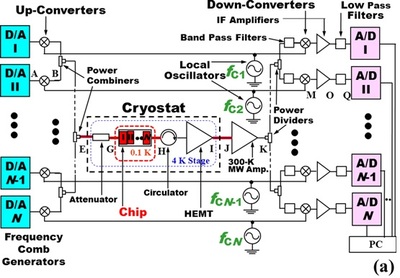Share this
Authors
Satoshi Kohjiro and Fuminori Hirayama
Abstract
A novel approach, frequency-domain cascading microwave multiplexers (MW-Mux), has been proposed and its basic operation has been demonstrated to increase the number of pixels multiplexed in a readout line U of MW-Mux for superconducting detector arrays. This method is an alternative to the challenging development of wideband, large power, and spurious-free room-temperature (300 K) electronics. The readout system for U pixels consists of four main parts: (1) multiplexer chips connected in series those contain U superconducting resonators in total. (2) A cryogenic high-electron-mobility transistor amplifier (HEMT). (3) A 300 K microwave frequency comb generator based on N(≡U/M) parallel units of digital-to-analog converters (DAC). (4) N parallel units of 300 K analog-to-digital converters (ADC). Here, M is the number of tones each DAC produces and each ADC handles. The output signal of U detectors multiplexed at the cryogenic stage is transmitted through a cable to the room temperature and divided into N processors where each handles M pixels. Due to the reduction factor of 1/N, U is not anymore dominated by the 300 K electronics but can be increased up to the potential value determined by either the bandwidth or the spurious-free power of the HEMT. Based on experimental results on the prototype system with N = 2 and M = 3, neither excess inter-pixel crosstalk nor excess noise has been observed in comparison with conventional MW-Mux. This indicates that the frequency-domain cascading MW-Mux provides the full (100%) usage of the HEMT band by assigning N 300 K bands on the frequency axis without inter-band gaps.

Superconductor Science and Technology : http://iopscience.iop.org/article/10.1088/1361-6668/aaa3c1
These Related Stories